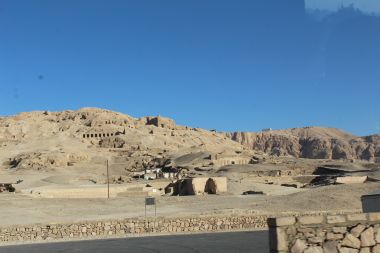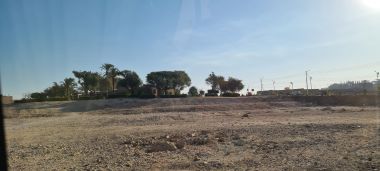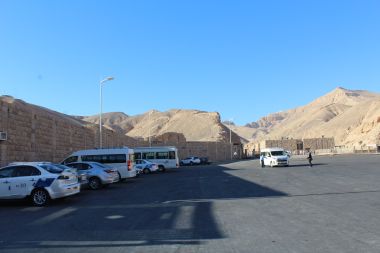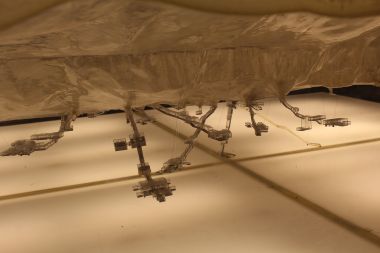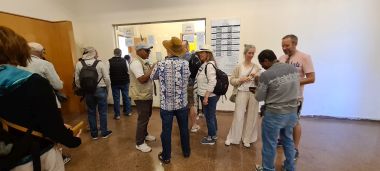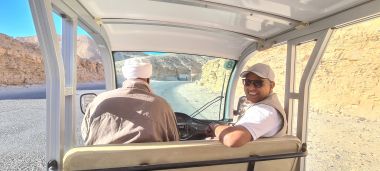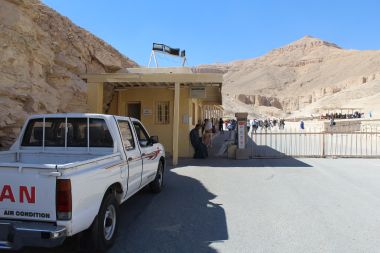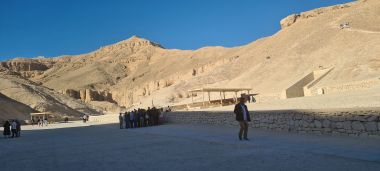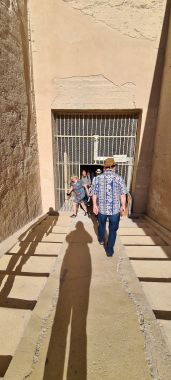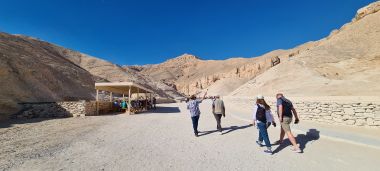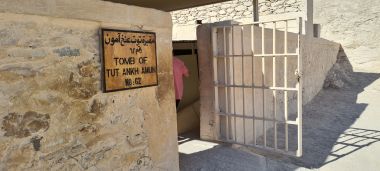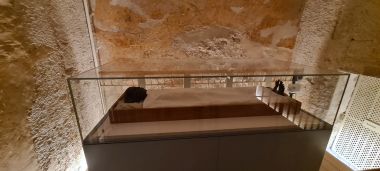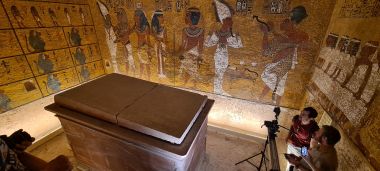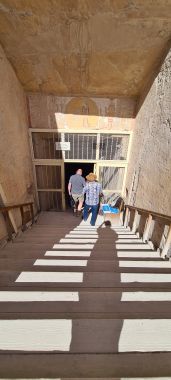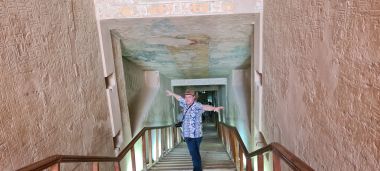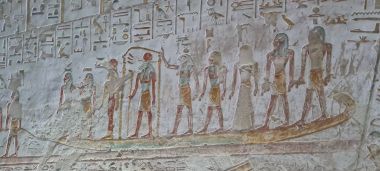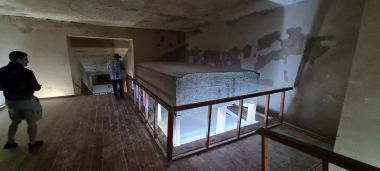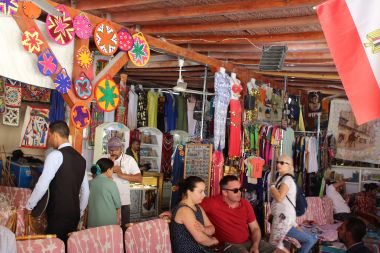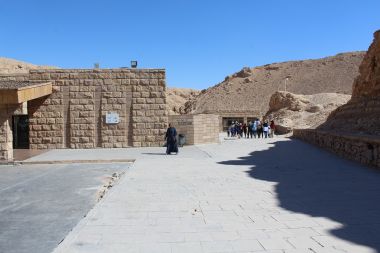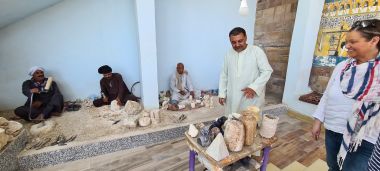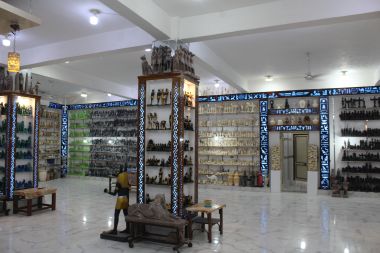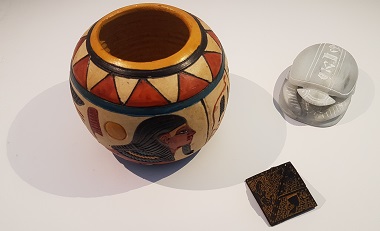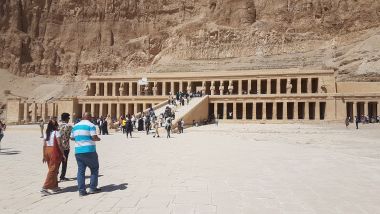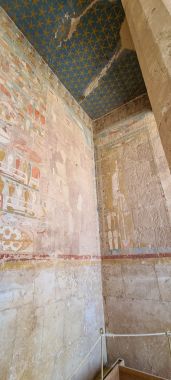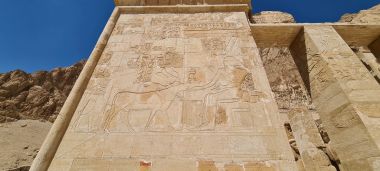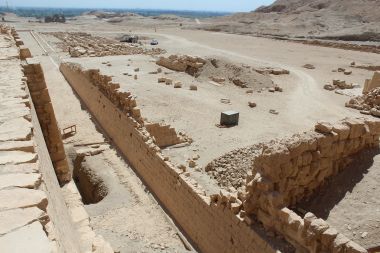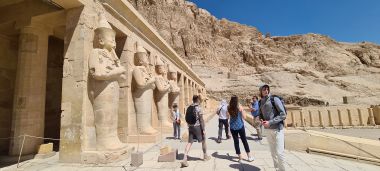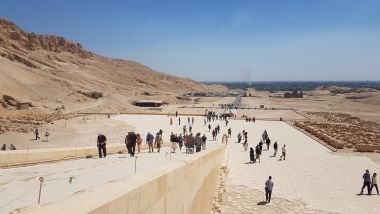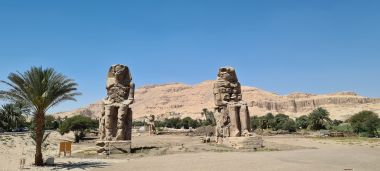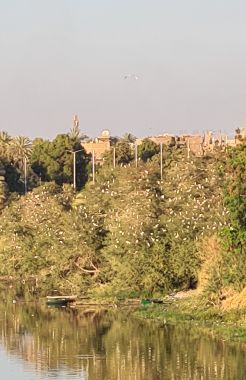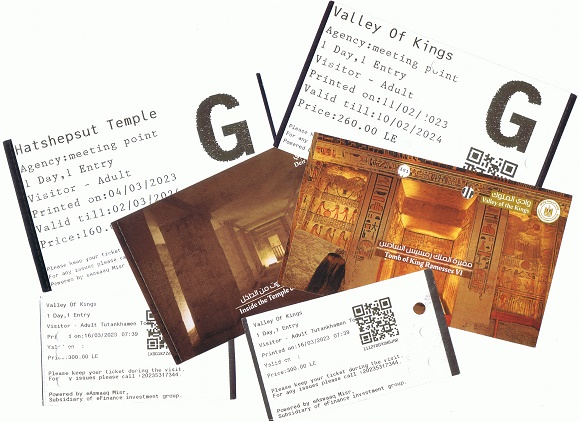Day 8 - Valley of the Kings - March 16, 2023
Another incredible day and a visit to the amazing Valley of the Kings. It started quite early at 5:30 when we got up for breakfast at 6. We met at Ahmed at 7 in the lobby. There are just six of us today including our guide and the driver as one of the other English couples left for the airport this morning. We crossed the Nile over the nearby Luxor Bridge to the west bank.
The west bank is full of archaeology easily seen as we passed by in the van - The two massive statues of the Colossi of Memnon on our right, which we would visit later, the Mortuary Temples of Rameses II (Ramesseum) as well as Seti I also on our right, and the road to the Valley of the Queens and the Tombs of the Nobles the to our left. We even passed by Howard Carter's house, the famous archaeologist who discovered King Tutankhamun's tomb, the only house with trees and green lawns surrounding it.
It was interesting to discover that they are still finding archaeology in the area with the government in the process of forcibly evicting people from their homes in order to excavate. There is no doubt that there is still much to discover in the Valley of the Kings.
The Valley of the Kings is where later pharaohs were buried having learned that building large monuments for their mausoleums, such as the pyramids, were easily ransacked. Only the pharaohs themselves knew were the valley was located and where their ancestors had been buried, blindfolding and otherwise obscuring the location from the workers. Interestingly we learned that many of the magnificent sites in Egypt were not built by slaves but rather by paid artisans as they have recently found lists of the salaries paid to workers.
The road to the Valley of the Kings has recently been resurfaced and is now a winding slick ribbon of black into the hills that ends in a massive car park with a small visitor centre which contains an amazing diorama that shows the geography above ground but, crucially, the archaeology below ground which shows the complexity and extent of the 65 tombs currently discovered in the area.
The entrance ticket includes admission to three tombs of eleven or so that are open daily and regularly rotate. Entrance to King Tutankhamun's small tomb is via a separate ticket (300 LE) to keep numbers down and Ahmed suggested it was not worth our time but we all insisted on visiting so got into a line to purchase these.
Having our tickets in hand we proceeded through security into a large open bare paved area where we waited a short time and caught a golf cart up to the main site entrance about 500 meters up the road.
All around us were the orange sands of the hills with evidence pointed out to us of the occasional disturbance of man looking for additional archaeology. At the gate of the main site they checked out tickets again before being let in.
The site is at the bottom of a valley with paved paths leading to the various tombs. The tomb entrances are easy to spot and well prepared with concrete paths and stone lined walls. Most have several placards outside explaining what is inside and all have a simple label of the king (or queen, we learned) who is buried there. Often there will even be covered seating areas for groups to rest.
All tombs have the same general structure with the main entrance having a metal grill gate with a small door where someone punches holes in your ticket on entry then a steep clean-cut rectangular hall leading down into a burial chamber with storage chambers off to the sides. They all have wooden walkways running the length of the tomb (to protect the floors) with handrails and walls well lit from below. None of the tombs, except for King Tut, contain mummies and any artefacts have been removed to safe keeping in museums. The tombs all show remarkably little decay with the low amount of precipitation in the area. The paintings and writing on the walls and ceilings are easy to make out and appreciate often with vivid colours that get more vivid the further they are away from the elements deeper in the tomb. There are lots of pictures of baboons which were considered erotic symbols connected to the cycle of birth, death, and rebirth. Of course, the tombs holding the preserved bodies of the pharaohs were to prepare the pharaoh for the afterlife and contained everything they might need there: Food, furniture, pets, etc.
A few explanations about the ancient Egyptian monument decorations:
- Hieroglyphics (“holy writings”) - The ancient Egyptian pictographic language can be written left to right, right to left or top to bottom. Look for the “bird” in the writing to show the direction in which to read.
- Cartouches - The names of royal people found in ovals with a line at their base. Often cartouches come in pairs, one for the birth name and another for their royal or official name. The hieroglyphics, whether inside a cartouche or not, can stand for what they depict, complete words/phrases, or, more often, they represent specific sounds (hence why you can get your name done in hieroglyphics in any Egyptian tourist trap). Often a cartouche will contain a bee which is the a symbol of the giver of life, birth, death and resurrection as well as representing both upper and lower Egypt.
- Pictures - Figures in a prone (horizontal) or upside down position are generally evil spirits. Gods, of course, generally all have animal heads.
Guides are not allowed in the tombs so Ahmed pointed out several nearby we might be interested in visiting while he went to have coffee at the nearby café. We were only given 45 minutes so had to move quickly.
The first tomb we visited was that of Ramses IV (“KV2”, see https://thebanmappingproject.com/tombs/kv-02-rameses-iv) which we had been told was highly decorated and this was most certainly the case.
The sharp cornered rectangular corridor was narrow, and steep with handrails on either side, decorated on the walls and ceiling with colourful paintings and loads of hieroglyphics as you might expect. The interior was well lit with unobtrusive lighting so we could take it all in.
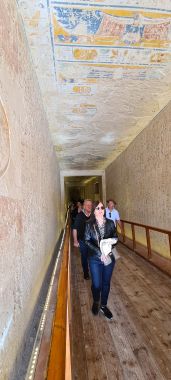
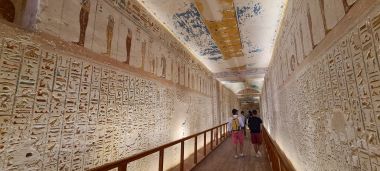
The further we got down the tunnel the more vivid and vibrant were the colours. Approaching the burial chamber the tunnel levelled off. The rock sarcophagus had rounded corners and was elaborately carved, filling the central part of the room. It dominated a small room whose walls and ceiling covered with rich carved painted scenes. There was a lot of yellow used and in the ceilings there were deep blues often studded with stars.
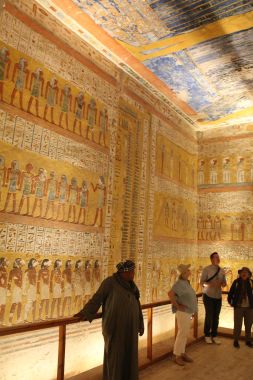
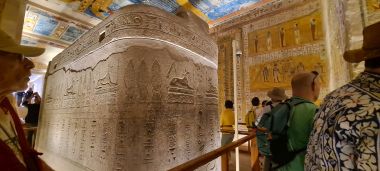
A local in the corner offered to climb up onto the railing to take pictures of the top of the sarcophagus. We had been told not to pay them as this sort of behaviour is causing damage to the site. Beyond the sarcophagus were a series of store rooms covered with hieroglyphics that were closed off but we could see into.
“Tut Ankh Amun's” tomb (“KV62”, see https://thebanmappingproject.com/tombs/kv-62-tutankhamen) is immediately opposite the small outdoor café where Ahmed was waiting. It's entrance is literally only a few feet below that of another tomb (Ramses V/VI, “KV9”) so it is surprising it was found so late. Climbing down from the path there is a small rectangular covered area with a few plaques describing the tomb and the entrance at the far side where we had to provide our ticket.
The short tomb entrance corridor is incredibly steep leading to a small, low ceilinged, rectangular room where the boy king was in a small glass display case to our left with no signage - We were told this is temporary.
To the right is the main burial chamber which was dominated by the red stone sarcophagus carved with winged figures. The yellow walls are simply decorated with pictures of baboons and scenes from the young king's life. He died at the age of 19 so they had very little time to prepare the tomb. There was a film crew in and they were taking detailed imagery all around the sarcophagus. We could see a store room to the right but the only access we had to the tomb was simply the rectangular room at the bottom of the entrance corridor.
Despite Tutankhamun's tomb being so small, simple and plain it was quite amazing to be walking around in, to actually feel and see the space around you. This is a piece of modern history that most people will be familiar with - The famous discovery by Howard Carter of an intact tomb containing marvellous artefacts often covered with gold. It has hugely shaped most people's understanding of ancient Egypt.
Next we visited the tomb of “Pharaoh Merenptah” (“KV8”, see https://thebanmappingproject.com/tombs/kv-08-merenptah) as Ahmed had told us it was a good example of a deep tomb.
He was right, inside was quite a steep incline and it went down a very long way (the tomb is 164 meters long, and descends at about 45 degrees all the way to the bottom).
The tunnel is decorated with carvings with some fairly badly damaged by water near the entrance but getting more distinct the further in you go.
Just before we reached the main burial chamber at the bottom of the tomb there was a room with the outer sarcophagus of Merenptah. The main chamber is quite large with a huge stone rectangular sarcophagus decorated fairly simply with it's lid on the ground beside it.
There were local people here offering to take pictures of the sections of the room that were closed to visitors (beyond the railings) but otherwise it was quite quiet here with lights only on the sarcophagus pieces themselves. The vaulted roof was supported by basic pillars and the walls showed few paintings which also appeared to suffer from water damage. It was quite a long way back up into the dazzling brightness.
Leaving the tomb of Merenptah we headed back down to the central path through the valley passing by a small tour group talking about the tomb. On either side above the tomb there were two small walls behind which Ahmed had told us they are searching for another tomb. One that they have been searching for is that of Tutankhamun's wife.
By now we were quite tired and running short of time so we visited a smaller nearby tomb. The tomb of “Ramses IX” (“KV6” see https://thebanmappingproject.com/tombs/kv-06-rameses-ix) was a lot less inclined and easier to take. The tunnel had glass panels on each side of the path to protect the walls which showed a bit of damage but were still elaborately carved and painted.
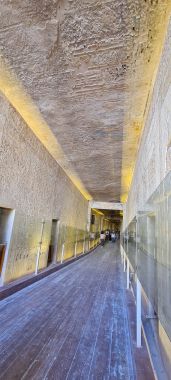
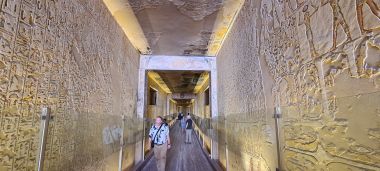
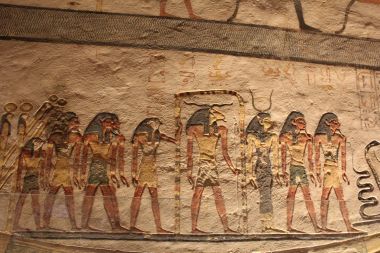
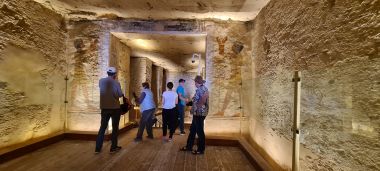
We were not allowed access to the burial chamber itself but saw it further on (again, another helpful local offered to go further and return with a picture if you wanted to pay a small fee…) though it was just a pit with no sarcophagus.
Ahmed and the rest of our group were waiting in the shade in the bustling café/gift shop in the middle of the valley. Though it was not hot the sun was quite punishing and refreshment was welcome as Mel had a coffee and I had a fruit cocktail that I know contained guava but I can't remember what else. It was fairly expensive but worth it as we wedged ourselves between people sitting on the bench looking across at the tombs.
As we walked out of the valley it was obvious this is still very much an active archaeological site with signs of digging and excavation along part of the valley to our right. On the question of why this particular valley, Ahmed showed us the quality of the stone here - Very solid and very stable, so a good spot for building tombs.
It was a bit sad to leave the valley of the kings. Mel and I both agree we will have to return to visit more tombs as they are absolutely fascinating and each quite different despite their similar layouts. It is surprisingly serene too with only the murmur of tourists and the plain orange hills all around. As we left the site of course we had to pass through the normal collection of souvenir stalls before we boarded our minibus.
Valley of the Kings Pictures (from Flickr)
At the bottom of the valley we turned onto the busy north south road on this side of the Nile then turned onto an unpaved side road leading to a building. Another tour day, another obligatory visit to a tourist shop this time it was the “New Bastet for Alabaster” shop evidently owned by a descendent of the young boy who discovered King Tutankhamun's tomb, Hussein Hassan Abdel Rassuhl. Indeed, inside there is even the famous picture of the boy wearing one of Tutankhamun's necklaces (which he later donated to the Cairo Museum).
Before entering we were given a demonstration of what good alabaster looks like and shown what fake looks like including a dramatic shattering of a plaster figure of King Tut. Behind the salesman were four men on the ground leaning on the wall demonstrating aspects hand working the alabaster. Amusingly, they chimed in periodically to accentuate the sales pitch “oh no!” and “wow, oh my god!” when he held an alabaster vase up to the light to show how translucent it is (evidently the lighter the alabaster the more likely it is to be hand made and machine made is shiny). A bit of a comedy act and it made it a bit different and fun.
Inside there were two large rooms lined with handicrafts as well as a small room off to the side containing replica pieces.
We wandered around and eventually decided on three things: A small black pyramid covered with hieroglyphics we bought for a friend who asked me to bring back a pyramid (though I suspect we will keep it for ourselves), an light grey alabaster scarab beetle, and a small round vase. We thought was a bit pricey but we were able to talk it down a little in the end to just over £100.
Despite it being only 10:30 we were already quite tired and we still had more to see. We headed to the other side of the hills on the south side of the Valley of the Kings to the Mortuary Temple of Hatshepsut. Unlike the Valley of the Kings the Temple of Harshepsut is not hidden away but is an impressive three-story structure built into the base of a cliff. Like Karnak Temple this complex consists of a number of temples for various Egyptian Gods. We were told that (Queen) Harshepsut acted as regent to her stepson Thutmose III when he became pharaoh at the age of two. A few years later she declared herself pharaoh and side-lined (and imprisoned) her stepson while she embarked on a building campaign across the country including this temple (and Karnak). She also stablized the borders and ushered in an era of stability and prosperity. On her death, her stepson once again became pharaoh and immediately took steps to remove her image from the temples (as with other sites, this was done by chiselling our her images).
As we arrived in the car park we could see in the cliffs to the right of the temple a number of holes that we were told are the tombs of the workmen and the architect. The temple is located literally on the other side of the hills from the Valley of the Kings.
The site was busy with a number of school children who are frequently taken to see the sites of their country. We passed through the normal security and ticket formalities before again boarding a golf cart which took us the long distance to the base of the temple stairs. It was getting quite hot by this point so the ride was appreciated. As with the Valley of the Kings, Ahmed had provided us with some tips as to what to see and arranged to meet us later in the café at the exit at 11:45 so we had just over 45 minutes to explore.
There are a pair of massive ramps leading to the levels of the temple with steps carved into the middle for the priests. Each level has a line of columns that looks quite Greek to me or something you would see on a government building. We immediately headed to the right of the second ramp on the second level to see the vivid paintings of the shrine of Anubis, god of funerary rights, amongst the pillars.
On the same level on the left of the ramp we visited the somewhat less vivid shrine of the cow-god Hathor, goddess of beauty, sensuality, music, dancing, and maternity.
Below the shrine there was evidence of ongoing excavations of the site with exposed foundations and scaffolding.
On the top level there were roped off areas where archaeologists were working on the statues in front of the pillars.
At this level we visited the shrine to Amun (Amon), god of the air, which is right in the middle and at the back. It is quite small and not terribly impressive - Just a box of room though with colourful paint on the walls including our favourite dark-blue, starred ceiling, arched in this case.
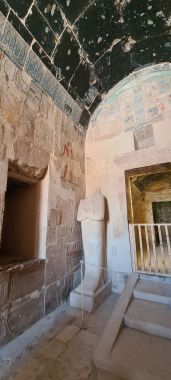
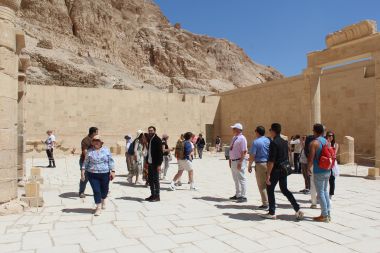
From the top level we had a great view east towards Luxor where we could make out the towers of Luxor Temple.
Of course, we were wandering around just to see what there was to see and as with other temples there are decoration and carvings on all surfaces. Here there are a number of side chambers that served various purposes that are also decorated. In most cases the state of repair is not great with a lot of the decorations having deteriorated over the years in the elements but a lot of colour and definition still remains and it is still quite impressive. There were a lot of children and other visitors to the site but it is so big it was not really a problem. I was quite uncomfortable with the heat and had to squint a lot with the brightness of everything - White/beige stone, sand and landscape in bright sun…
Temple of Hatshepsut Pictures (from Flickr)
At the café it was great to have a respite from the sun and we purchased some rather overpriced soft drinks. As always, we were the last to join the other - We want to make the most of our time here. Anyway, after the obligatory tourist stalls we were back in the car park and picked up by the driver. We returned along the road we had taken this morning past Ramesseum then left onto the road that takes us over the Nile where we stopped at the Colossi of Memnon rather than driving past as we had earlier. These are two massive statues, in very bad repair, just beside the road which you can visit for free (for a change). We stopped in the small car park and got out to have a closer look.
The Colossi of Memnon are two massive stone statues of Pharaoh Amenhotep III standing side by side in the ruins of the Mortuary Temple of Amenhotep III on the edge of a busy road. They have suffered many times from earthquakes so now are quite damaged but impressive nonetheless. It is said many of the temple stones have been taken away by local people to build their houses leaving not a lot remaining.
There was not really a lot to say or see here so a short time later we were back in the minibus to return to the boat at about 12:30 pm where we handed the driver a 500LE tip then had a chat with Ahmed in the lounge about our pick-up for the airport to Cairo tomorrow morning. It will be another earlier start with breakfast starting at 6 am and pickup at 7:15 am.
Lunch was at 1:30 pm after which we spent the rest of the afternoon on the top deck under the shade. We exchanged contact details with our fellow English passengers but generally relaxed all afternoon. At one point I was happy to spot a hawk fishing around the ship then later a kingfisher. The kingfishers here are quite plain black and white birds as opposed to the vivid blue colour they have elsewhere. A tree just down river from us was also full of white egrets that seemed to be meeting to roost of the evening.
Dinner was at 7:30 and for this last meal we joined the other English passengers at their round table beside ours as their fellow German diners had already left. The dining room was not very busy at all with many people missing. It is a bittersweet time. We are very much looking forward to Cairo but will miss our boat on the Nile.
At 8 pm we paid our bill at the front desk. I had been a bit worried as I was told the credit card machine was broken and I was not sure I had enough cash to cover everything but as it turns out it was only £70 for all of our drinks for the past 6 days and we had enough (British) cash to cover this. As we packed up in our room we did take some pictures for the travel agent to let them know of the bathroom which is not great…certainly not the five star we expected.
Looking out the window at the waters of the Nile towards the buildings on the west bank and the garishly lit mosques. In the far distance on the cliffs we could see the temple of Harshepsut was lit up. This is a view you don't see every day.
⇒ Continue to Day 9 - Luxor to Cairo - March 17, 2023
